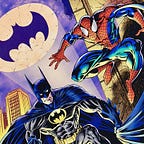The Selected Batman Re-Read, Part Five — The Mid- to Late Nineties and Early Two Thousands
If the late eighties were all about psychologically-driven Batman stories, the nineties to the early two thousands were mostly about the big and splashy.
The biggest and splashiest was, of course, Knightfall where Bruce Wayne gets his back broken by Bane, and passes the mantle of Batman to some dude named Jean-Paul Valley who is seemingly haunted by the spirits of a dead saint and his dead dad, though it’s probably also the effects of mental programming that turned him into a master assassin. Or something.
Look, I get that maybe the trades in which I read this story might not have done it justice and didn’t provide enough context to make Valley a sympathetic enough character, but I honestly don’t know how Knightfall gets away with not getting shat on the way that Spider-Man’s Clone Saga did.
Don’t get me wrong, as I’ve written about extensively, The Clone Saga had a lot of flaws, but at its core was a decent enough story. Knightfall started out strong, with Bane’s origin, as well as Bruce’s slow physical and mental breakdown after Bane’s assault on Arkham, being genuinely compelling reads.
But the moment Valley took over, it turned into a chore. It’s not just that he’s such an incredibly unlikable character. The individual stories themselves are mind-numbingly boring, with some of the most forgettable villains ever. When that slog of a story with Abattoir finally reached its conclusion, I couldn’t believe how much time was even wasted on it.
There seemed to be no actual overarching direction to the overall saga too. It’s almost as if DC had decided that they needed to do the controversial thing and have Bruce temporarily replaced, but they didn’t know what to do with his replacement.
The third act, after Bruce returns and then, for some reason, passes the mantle over to Dick for a little while, was a bit better, but after the mess of Valley’s tenure in the (armoured) cowl, it’s not like the bar was set particularly high.
Then there’s arguably the first big Batman event of the two thousands — Hush, Jeph Loeb’s return to the character, joined by Jim Lee. And make no mistake, while this story’s main thrust is a mystery much like Loeb’s most well-regarded work on the character, this is still more an event than anything else.
It’s a greatest hits of Batman supporting characters and villains, but they’re all held together by a story that’s a little too straightforward. A lot of that has to do with Jim Lee. That’s not to say that his work is terrible here — it’s actually rather dynamic — but because action is Lee’s forte, that’s what Loeb has to play to with his script. So, what you get is a mystery that’s not as engaging as Loeb’s previous work buried under an event comic that’s fine for a read or two, but doesn’t hold up as well over time.
Immediately following Hush is Brian Azzarello and Eduardo Risso’s Broken City, which is the one non-event story I’m covering in this post, and actually is very much a mystery, with quite a delightfully twisted resolution, no less.
Azzarello’s hard-boiled style here seemed like an odd fit at first — not exactly channelling Frank Miller’s Batman, but leaning more towards Miller’s Sin City — but as the story progresses, his take begins to make sense and actually accentuates the story itself.
And while Lee’s style hampered Loeb’s story, Risso’s style only serves to elevate Azzarello’s, with its shadows and grime coming out as the real star of this story, much in the way David Mazzucchelli’s art was the crowning piece of Year One.
Finally, there’s Under the Red Hood, predominantly by Judd Winick and Doug Mahnke, which while not as big in terms of scale as Hush, arguably had a much greater impact on the Bat-family.
This one actually starts off very solid. There’s a nice balance of humour with the mystery of who the new Red Hood is, and his three-way war with Batman and the Black Mask. Where it starts to falter, however, is after the big reveal. Having it be Jason Todd was not the issue. What really brings this story down is tying how Jason came back too much with other stories. The Superboy Prime punch was enough to take me out of the story, but retrofitting Jason into Hush just made it worse.
A lot like the late eighties and early nineties, this era’s a mixed bag. Unlike that previous era though, there’s more so-so bits than good ones here—and even then, the good’s not exactly stand-out stuff. (Mostly) not terrible, sure, but nothing particularly memorable either.
(Originally published on 21 September 2019.)
